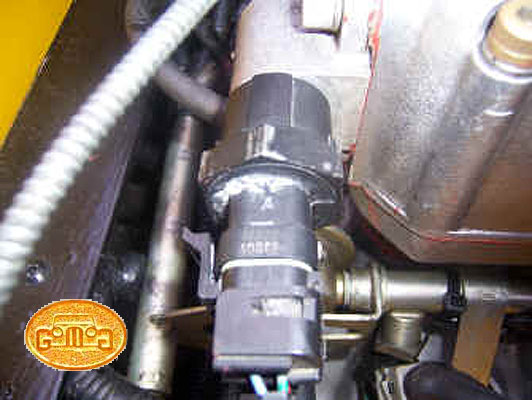
https://www.youtube.com/watch?v=TO-TQcCXQS4
The symptoms are an erratic or high idle
This is a fairly crude affair, utilizing an air bypass screw (called the base idle setting) and a simple stepper motor controlled air valve to keep the idle steady as the engine loads vary. The stepper motor has 180 different step positions, and each time the ignition is turned off, the stepper motor pulls the air valve wide open, by being pulsed 200 times. As only 180 steps are available, it will always reach a "home position", and from this point the ECU keeps track of its position by counting pulses from the home position.
Idle Stabilizing System and its Issues
The stepper motor is always the first
culprit for unstable tickover, but due to a very crude "pulse and wait"
system used by the ECU to stabilize the tickover, other factors like the
wrong CO settings, air leaks and wrong timing can cause the the engine
revs to rise and fall as if the stepper motor was sticking. If you have
cleaned the stepper motor shaft (as below) then look else where before
replacing the stepper motor.
 |
Air control valve. This comprises of a stepper
motor, with a worm drive that moves a conical valve to control the amount
of air by passing the throttle butterfly, and hence the tick over. Very
prone to sticking due to carbon and oil build up from the plenum chamber
(made worse by using a sports camshaft), leading to erratic tick over. See below for more. https://www.youtube.com/watch?v=TO-TQcCXQS4 |
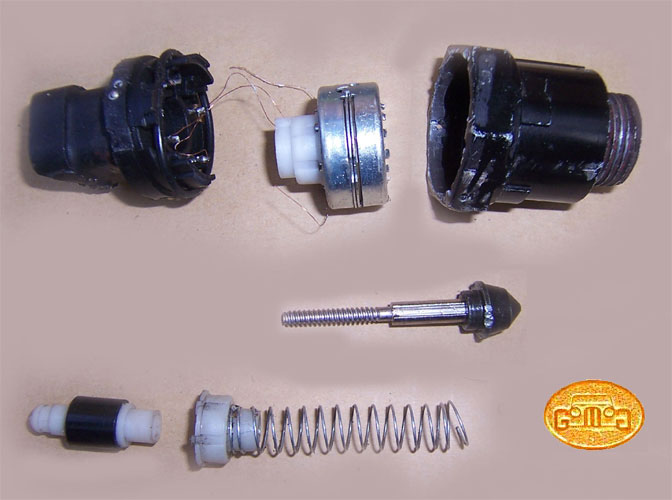 |
Component parts, comprising of motor, tension spring, control valve, rotor and screw cap. There is also a metal bearing in the housing that can become dirty and corroded. Its not possible to strip a unit this far unless its scrap! |
TESTING THE STEPPER MOTOR
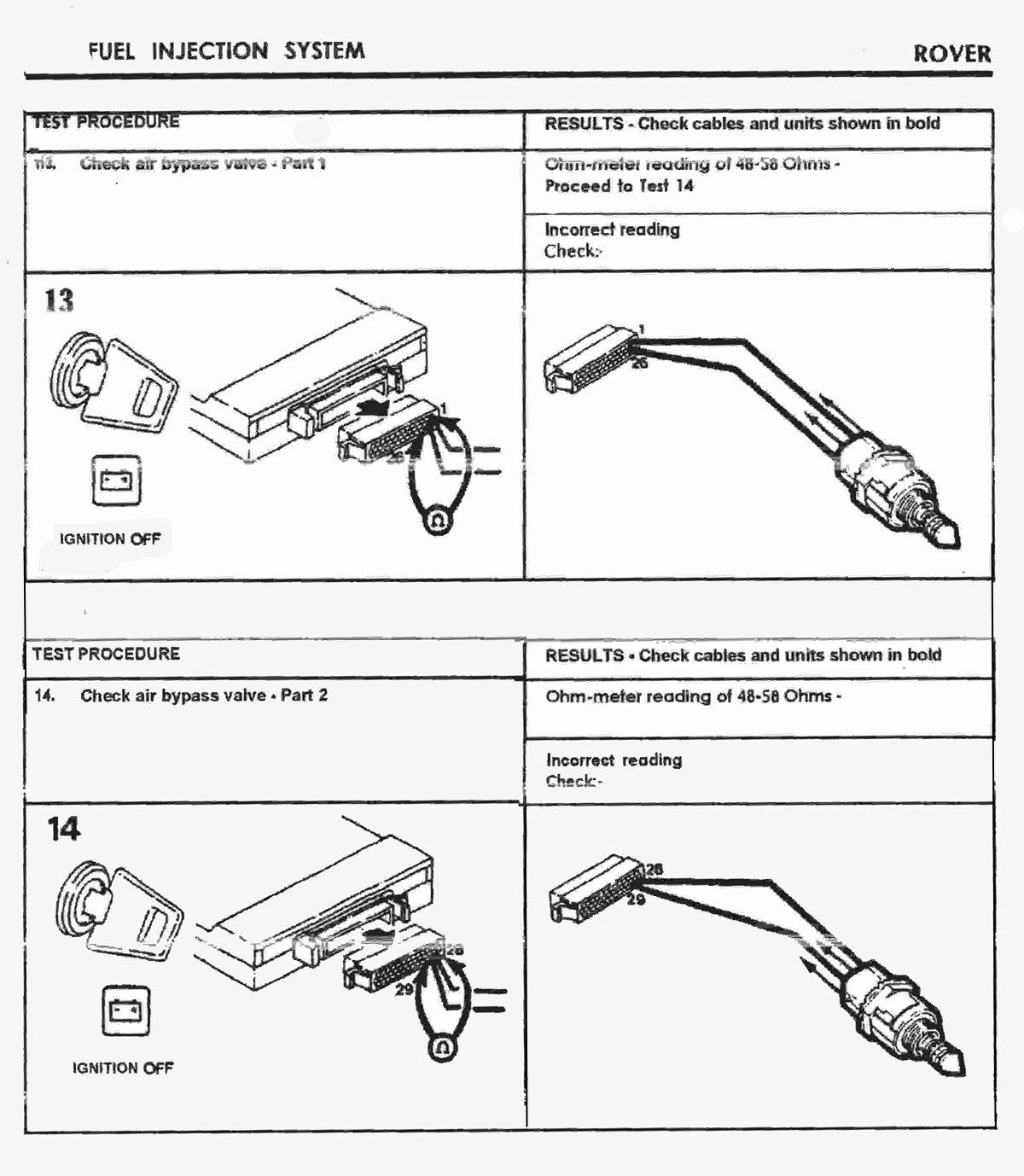
Cleaning the Stepper Motor
At
its simplest the motor can be unscrewed from the plenum housing, and all
the carbon and oil deposits removed from the head of the metering cone,
and some use of carb' cleaner on the keyway may be enough to get the unit
working. Its also worth cleaning out the metering hole inside the plenum.
If it still sticks then more drastic measures may be needed. I have
now perfected a way of getting them to bits to clean, without damage:
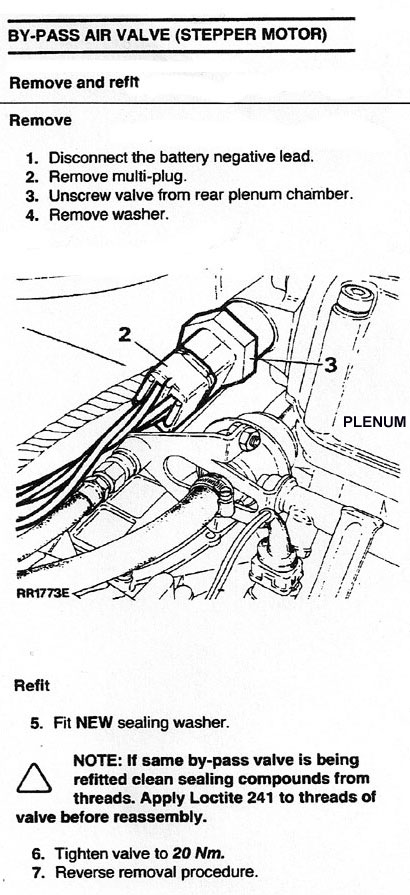 1)
Get the car warm
1)
Get the car warm
2) Remove the stepper from the plenum and reconnect it.
3) Block the hole the stepper has come from with something air tight, or even the palm of a hand.
4) Hold the stepper so you can catch the central cone and spring when it comes out.
5) Get someone to start the car. Without the stepper in place it will rev at around 2k- 2.5k (This is noisy!!), but the ECU will try to slow it down by powering the stepper motor and pushing cone outwards. It will do this in a series of pulses, a few seconds apart, until the cone and spring drop out. (assuming they are not completely stuck). It may take a bit of manual help to get the cone to fully release. Now stop the engine and let it cool.
6) Clean all the muck off the shaft and cone, and lightly lubricate the screw thread inside the motor.
7) To reassemble, wind the shaft back into the motor so far, but align the slot in the shaft with the plastic keyway as best you can by rotating the shaft in its screw thread
8) With the engine cool, then reconnect the stepper motor. Power cycle the ignition on and off, (don't start) and the ECU will try to pull the shaft back in each time the ignition is turned OFF. This is the slightly tricky bit, as if the keyway and shaft are not quite aligned it wont pull home, so you may need a few attempts.
In a few cases cleaning does not resolve idle issues, and this can be due to corrosion in the metal bearing in the rear of the stepper housing becoming mucked up or corroded, and this requires a new unit.
One weakness of this system, is if the stepper motor sticks, the ECU looses its correct position, as there is no feedback to say where it is which leads to an unstable idle. Another weakness is how it crudely controls the tick over. If the engine is running above the required RPM at tick over, a burst of pulses is sent to the stepper motor to reduce the air supply. The ECU then waits a few seconds for the mechanics of the engine to respond. This time "constant" depends on the engine dropping its RPM in a fairly controlled manner. Further tweaks then take place if the RPM is still outside tolerance. A problem occurs if the engine RPM drops faster than predicted due to fueling errors, or ignition problems, so the engine RPM drops too far. After the wait time the ECU detects the RPM is now too low, and winds the stepper motor back again and waits again, at which point the RPM goes too high. The process then repeats itself, so the idle remains very unstable.
Replacing the Stepper Motor
This is a straightforward task taking minutes. Frankly, it is my preferred advice as the right stepper motors have become available on the internet at very reasonable prices. If you have any questions or need assistance sourcing the right ones, you can contact me at webmaster@gomog.com
https://www.youtube.com/watch?v=TO-TQcCXQS4 From time 4.18
A foreword. Car engines, especially EFI have a dual task. Engines run their best at the rpm presumed to be "running speed". However, they must all run at idle..an rpm effectively set by our sundry governments with priorities having nothing to do with engine happiness. Advanced EFI give no options for idle speed, unless you wish to have experts change the idle the government gave your engine with computer intervention. THERE IS NOTHING SACROSANCT ABOUT RECOMMENDED ENGINE IDLE It is chosen to match emission and fuel usage regulations. It has nothing to do with your preferences of engine health. The carburettor fellows know this better than EFIers as they have more control on their car than current car owners. Every year automobile owners are allowed less control of their automotive property and the owners have responded by losing the skills they once had. :( Frankly, I find one of the most, if not THE most pleasurable characteristics of traditional Morgans. Up to 2000, they allowed owners to have a FULLER interaction with their cars inside their own garage or driveway!
Up to 2000 with all Plus 8s, outside Overseas Models (The USA and Downunder), Hotwires were still largely susceptible to owner choices. Assuming the idle is not prejudiced by other areas (stepper motors and ignition issues), owners can still set their idle as they could with the early Flappers. Those who are fixated on a specific idle are just that, fixated. ;) Lower the idle before a MOT or emissions check if you are in a jurisdiction that tests your Morgan regularly. For others, even just for the purposes of experimentation which increases you comfort with your hobby, look to the idle setting instructions below.
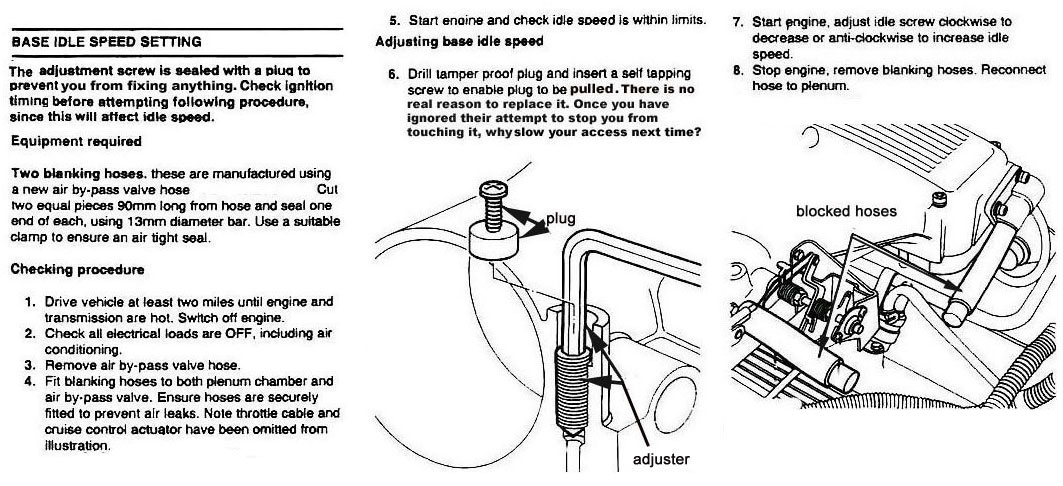
| WATCHPOINT: Cheap eBay Stepper Motors The OEM part typically costs between £70 and £90, but there are cheap units for around £20 available on eBay. These are Chinese copies, and, at least in the past, have proven not to work well. The biggest issue is air leaks around the motor, or the shaft length being about 4mm too long. The shafts can be removed (as above or using RoverGauge) on these and then cut down to match the original shafts and they will then work. The shafts are not interchangeable between the OEM and copies. |
Setting the Base Idle
At the base of the throttle body, you will notice a small round plug. If it is not already removed, you will need to drill a small hole in the center of the plug. Once the hole is drilled insert a small self-tapping screw into the hole you have made. Using a pair of needle nose pliers between the screw head and the plug, pry the plug out of the throttle body. With the plug removed you will notice an Allen head screw (or a flat head on some models) whose adjustment you will tackle after step #2.
Step #2
Find the black hose connected between the side of the throttle housing and the rear of the plenum. Disconnect this hose and plug both ports. While you have the hose off the plenum chamber and with a small brush, scrub out any carbon that may have accumulated in the chambers.
Step # 3
Start the engine and with the proper Allen wrench (or screw driver) adjust the idle RPM by turning the screw clockwise to decrease the RPM and counter-clockwise to increase RPM. The base idle should be set at 525 +/- 25 rev/min. Once this is done, turn the engine off, unplug the ports and re-install the hose(s). Now you should set your timing. The car should now idle smoothly at rest and run cleanly when coming to a stop.
There are many possible faults that can effect the idle but three are so common and the symptoms so distinctive that it is worth noting simply to provide a short-cut to diagnosis and repair.
The car will start normally and run well. However, it will stall at stop signs or lights.
1. FUEL TEMPERATURE THERMISTOR (SENSOR)
If the car stalls when it is run for a while and it is necessary to allow it to cool to restart, it is likely a defective fuel temperature sensor. I have ran across these symptoms over and over again as these systems age. This sensor is the item pictured here...found on the left side of the engine at the front. Frankly, for all those running on a 14CUX, it is worth buying one as a spare and leaving it in the car.
A very simple resistance test will give a good indication
of the health of the sensor. Disconnect the sensor, and probe it with the
multimeter set to measure resistance. The resistance should be approximately
2400-2600 Ohms at 20 degrees Centigrade, and 300-400 Ohms at 80 degrees
Centigrade. Do not probe for too long at a time as the sensor
is delicate and can be damaged by the multimeter's current.
| WATCHPOINT: Forgive me this one, but I have just been asked this question. One should NEVER boil this thermister to determine whether it is properly functioning. That is a test one uses with a mechanical device, notably the coolant thermostat. But a thermister is a delicate sensor that sends a resistance signal to the ECU. Boiling it would be analogous to boiling a computer part and the result will be the same. You will destroy the thermister. While I applaud any attempt to mechanically interact with your Morgan, a 100 year Morgan tradition, always consult with a competent Morgan forum first until you build up some basic knowledge. |
2. COOLANT TEMPERATURE THERMISTER
Similar in operation to the Fuel Thermister and can be
tested in the same way. The Coolant Temperature sensor is used to enrich
the fuel mixture when the engine is cold. These devices almost always fail
open-circuit, which makes the injection system believe that the engine
is at somewhere 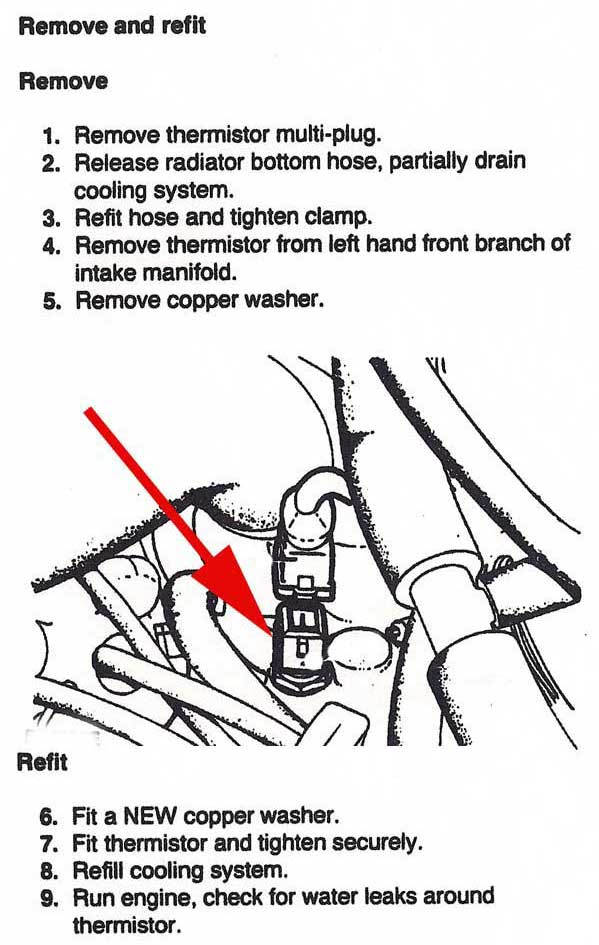 around
–40 degrees Centigrade. The system will always detect this as a fault condition,
and use a substitute value of 30 degrees Centigrade whilst setting a fault
code in the ECU. In practice this means that the car will be difficult
to start when cold (too lean), and will be too rich when warmed up. However
it will usually get you home!
around
–40 degrees Centigrade. The system will always detect this as a fault condition,
and use a substitute value of 30 degrees Centigrade whilst setting a fault
code in the ECU. In practice this means that the car will be difficult
to start when cold (too lean), and will be too rich when warmed up. However
it will usually get you home!
The same resistance test works as those found for the Fuel Temperature Thermister.
3. THE ROAD SPEED SENSOR (aka transducer)
The vehicle will tend to stall when you pull up to a stop. A fault code will be set in the ECU, which effectively disrupts operation of the Oxygen feedback system on catalyst equipped cars. The reason for the stalling with a defective (or absent) Road Speed Sensor is quite simple. Under normal operation when slowing down for a halt, the throttle may be unused but the engine is turning through the moving inertia of the vehicle as the car is often still in gear. Because of the presence of the Road Speed Sensor, the ECU will not try to adjust the idle in these circumstances, so the idle control valve is held open until the vehicle halts. The effect of this is that when the vehicle does halt, the idle valve is open and the ECU drops the engine onto idle smoothly.
However if the road speed signal is not present then the ECU attempts to adjust the idle whilst the engine is coasting to a halt. Obviously this is a task it cannot accomplish – a fact that is recognized by setting a fault. In this case the idle valve will be closed as the car comes to a halt because the ECU has been trying to shut down the idle speed. Therefore a stall will occur if the ECU cannot re-open the valve before the engine stalls.
Diagnosis of this one is simple. (or one can use the other diagnostic procedure indicate in the GoMoG HotWire section). The road speed signal appears on the yellow wire at the main connector where the fuel injection loom plugs into the vehicle body loom. One monitors the Yellow wire with the positive probe of the Voltmeter, with the negative probe connected to a good chassis ground. Switch on the ignition, and roll (or drive) the vehicle slowly in whichever direction is most convenient. The signal should go up and down between 0-2.0 Volts and 10.5-13.0 Volts, changing every 4-5 meters. This signal is 8000 pulses per mile.
Morgan poorly grounded these devices and it is not unusually for the Road Speed Sensor to lose its ground either constantly or intermittently. Alternatively, the sensor can be defective.
The sensor is fit into the speedo cable that comes from the gearbox.
OTHER ISSUES CAUSING A PROBLEM IDLE
1. Check
that the water temp sensor and the fuel temp sensor connectors have not
been swapped. The fuel temp sensor sits on the fuel rail and should
have a gray connector. The water temp sensor should have a brown
connector. These connectors often get swapped, one for the other, and
subsequently cause heavy fuel consumption and idling problems.
2. Faulty water temp sensor (EFI). Replace with new.
3. Air
leak in the rubber pipe running from the throttle body to the stepper
motor housing. Or generally a vacuum leak. Vacuum (aka air) leaks
cannot be detected by a diagnostic feature or OBDII code reader.
However, they can be detected by a hand held can of ether (often sold
under the name of QuickStar as a starter aid). Merely lightly and
quickly spray suspected air hose junctions (while avoiding the air
intake). Any change in rpm means you have discovered an
vacuum/air leak. Fix it.
4. AFM defective which won't cause idling to hunt up and down, but will cause heavy fuel consumption, clean inside and the hotwire element and temp thermistor with carb cleaner, Work very carefully not to damage the hot wire element.
5. TRANSDUCER A transducer is a generic term for a device that takes one type of energy and transforms it into another. In British automobile terms it is most often used for a item that takes the rotational signal from the odometer cable from the transmission. (There is a little plastic gear in the transmission that turns the cable.) The cable then goes to the transducer which sends a signal to the ECU as an necessary input for proper engine management, In later cars, the odometer themselves are run by the ECU as well but on Hotwires, along with the wire's signal to the ECU, a second section of cable travels from the transducer to the odometer. Sadly, like many devices under the dash, the transducer is ofter attached at the factory to the wooden bulkhead frame. In any event, it is a very common event that the holding screw loosens and the device loses its earth/ground. OR it can simply become defective. When this happens, the idle can be affected and the speed control becomes fault. The cure is simple.Tighten the screw (if the hole is loose repair it) or replace the device. There is more on this here on Page 66.